Grasshoppers: Identification, Monitoring and Management
Grasshoppers are a diverse group of insects with many ecological roles. There are 85 species of grasshoppers in Manitoba, and 180 species in Canada. There are 4 species of grasshoppers on the Canadian prairies that when populations get high can potentially be pests of crops. Grasshoppers that can be pests generally feed on a wide range of plants (including crops), and are capable of laying considerably more eggs than non-pest grasshopper species. For farmers and agronomists needing to protect crops from grasshoppers, it is good to know pest from non-pest grasshopper species, different stages of grasshoppers, how to monitor for grasshoppers, how many is an economic threat to the crop, and what are the management options.
Non-Pest Species of Grasshoppers
Grasshoppers are an important source of food for many species of grassland birds. Recognizing pest from non-pest species can help in managing those grasshopper populations that are a potential threat to a crop while not harming non-pest species, which can have a valuable ecological role.
There are a few general guidelines that can help distinguish non-pest grasshoppers from the potential pest species:
- Any grasshopper flying before June is not a pest. All of our potential pest species of grasshoppers overwinter as eggs. There are a few non-pest species that overwinter as nymphs. In addition, the pasture grasshopper and clubhorned grasshopper, both non-pest species, hatch in early-spring, while our potential pest species all hatch in mid-spring.
- Any grasshopper with hind wings highly visible in flight (red, yellow, orange or black) is not a pest.
- Any grasshopper that sings, clacks, or clatters is not a pest. The pest species are silent.

Figure 1. Meadow katydids; a non-pest species of grasshopper.
Katydids: There are 44 species of grasshoppers across Canada, 9 of which occur in Manitoba, called katydids or long-horned grasshoppers. The antennae of this group often extend beyond the tip of the abdomen, and none of these are pests of crops in Canada.
The four potential pest species of grasshoppers belong to a group called the shorthorned grasshoppers (Acrididae). There are 129 species of shorthorned grasshoppers in Canada, 71 of which can be found in Manitoba.
Potential Pest Species of Grasshoppers
The four potential pests species of grasshoppers in Manitoba are the migratory (Melanoplus sanguinipes), twostriped (Melanoplus bivittatus), clearwinged (Camnula pellucida) and Packard (Melanoplus packardii) grasshoppers. Pest species of grasshoppers tend to increase rapidly during years of warm, dry weather.
Identification tips:
Migratory grasshopper: This species has remarkable variability in colour and physical characteristics such as length of wings. Females are slightly larger than the males.
Adults:
- Adults are brownish to yellowish.
- There is a dark stripe just behind each eye (Fig. 2).
- Their hind legs have a series of black bands.
- The forewings have rows of small dark rectangular spots like the windows on an aircraft.
Nymphs:
- There are black stripes on the head.


Figure 2. Migratory grasshopper adult Figure 3. Migratory grasshopper nymph
Twostriped grasshopper: This is the largest of our pest species of grasshoppers, with adults getting to approximately 26 to 40 mm in length.
Adults:
- They have two pale stripes extending from the eyes to the tips of the forewings (Fig. 4).
- There is a solid black stripe on the hind legs.
Nymphs:
- Nymphs vary in colour from green, yellowish-orange or tan. They have two stripes on the thorax (segment behind the head).
At high densities, twostriped grasshoppers develop longer wings and slimmer bodies and are more adapted to flight than are low density, solitary individuals.
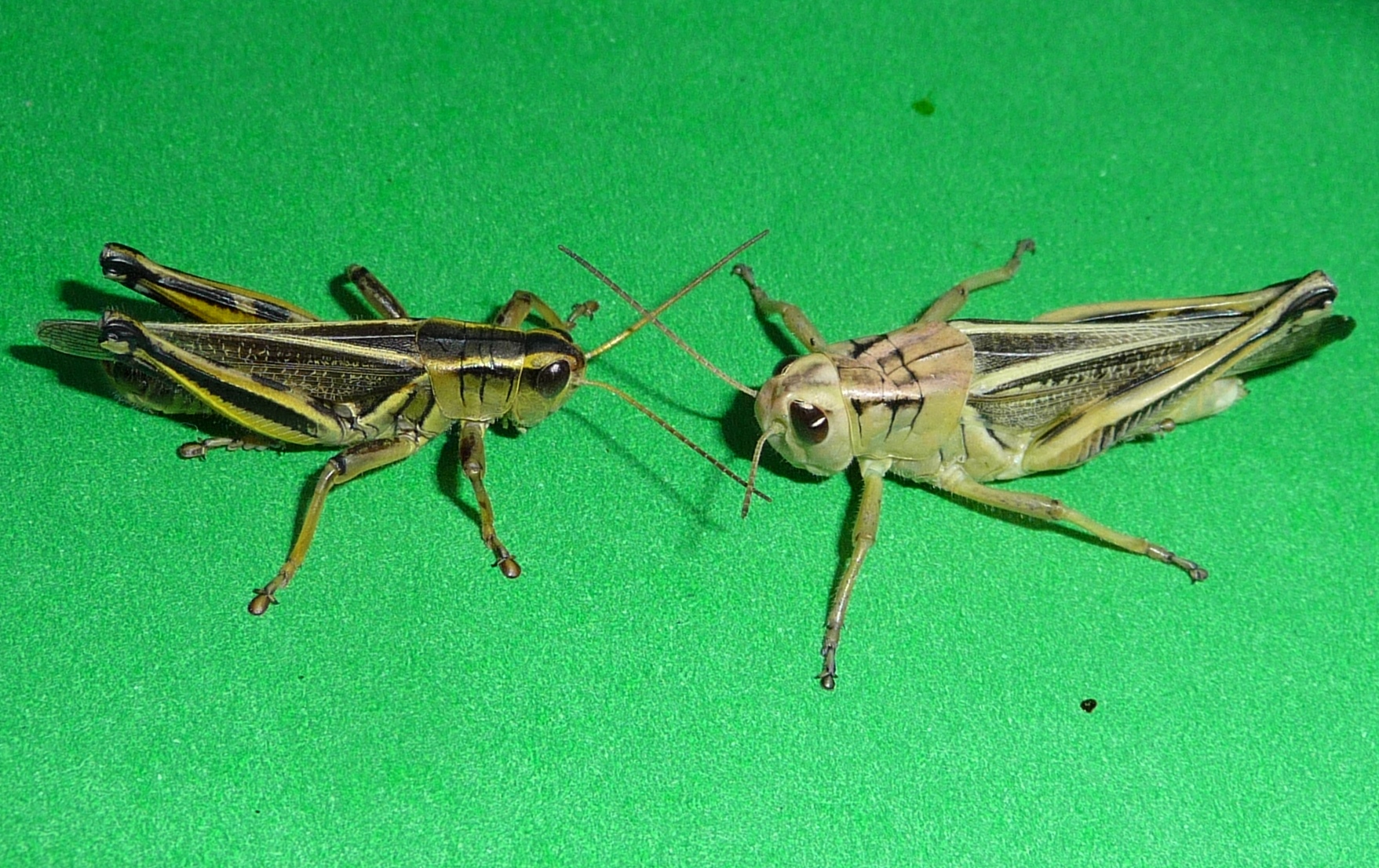
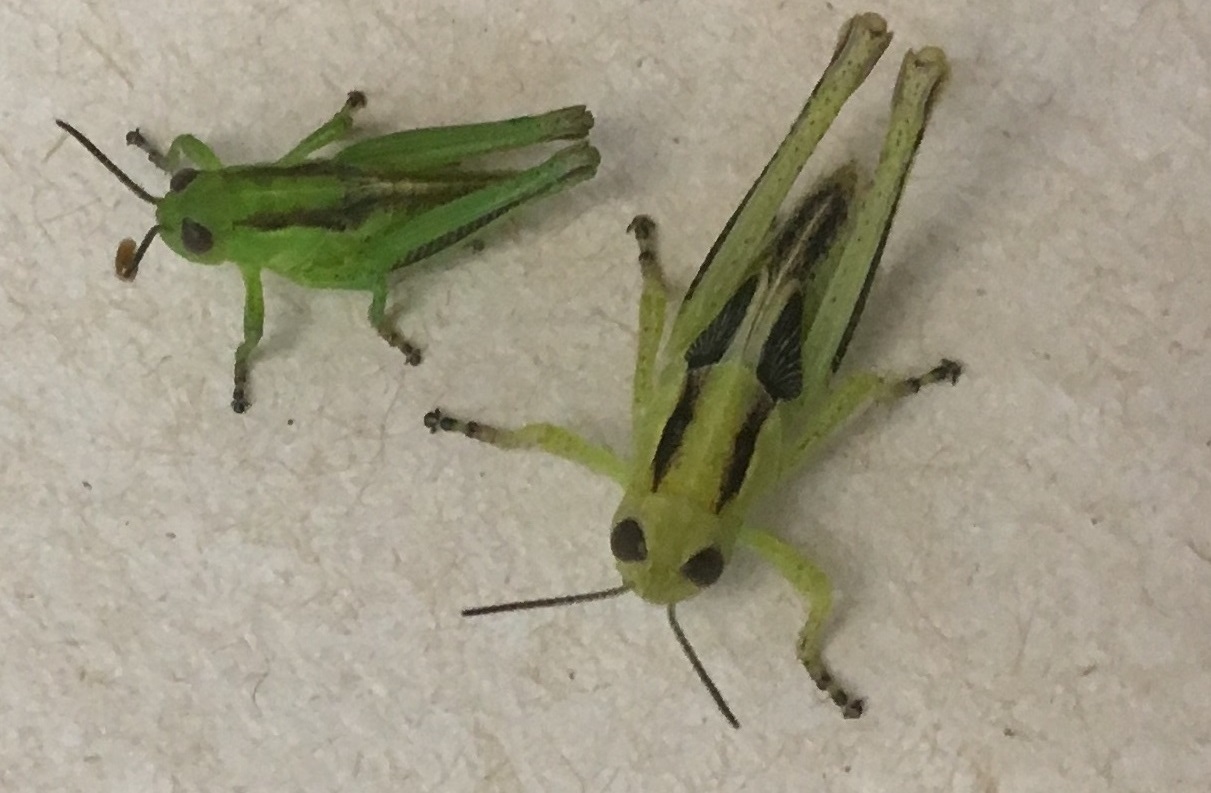
Figure 4. Twostriped grasshopper adult Figure 5. Twostriped grasshopper nymph
Clearwinged grasshopper:
- Adults are yellowish to brownish.
- The name of this grasshopper is deceptive. The wings are clear, but mottled with dark patches, and have two stripes that start at the thorax and converge at the tip of the forewings.
If the stripes on the back seem to confuse identification with twostriped grasshopper, use the brown blotches on the forewings to distinguish.

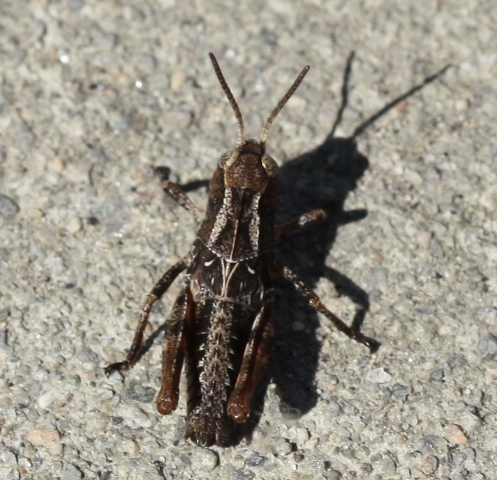
Figure 6. Clearwinged grasshopper adult Figure 7. Clearwinged grasshopper nymph
- Adults are grey to dark yellow.
- Two light-coloured stripes extend from just behind the eyes to the back of the thorax.
- The last two segments of the legs are blue-green.
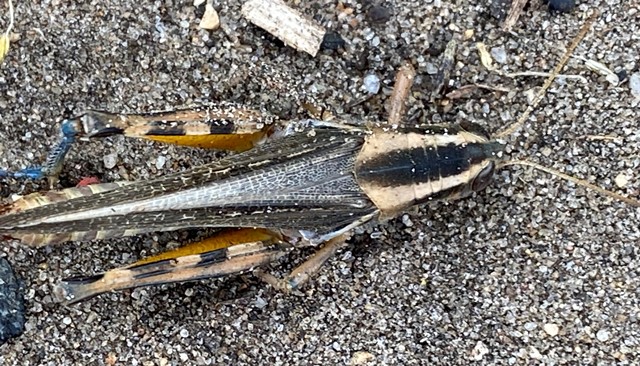
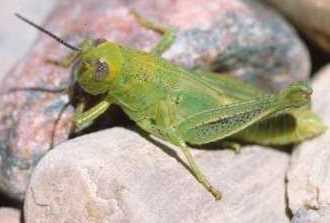
Figure 8. Packard grasshopper adult Figure 9. Packard grasshopper nymph
Habitat and Food Preferences
Food preferences and habitat depends on the species.
Migratory grasshopper feeds on both grasses and broadleaf plants. They will also feed on dried materials on the ground including plant litter, cattle manure, and bran flakes. At high densities a behavioral change occurs and migratory grasshoppers become gregarious, moving as a group.
Twostriped grasshopper is common in the heavier-textured soil zones. They feed on both broadleaf plants and grasses, but prefer broadleaf plants. They will also feed on dry litter found on the ground. Eggs start to hatch about 8 to 10 days before those of migratory grasshopper, and the hatching period may last for 4 to 6 weeks depending on soil temperature. It takes about 40 days for the nymphs to develop into adults.
Clearwinged grasshopper is primarily a grass feeder, and seldom feeds on broad-leaved plants.
Packard grasshopper prefers light textured soils. They feed on broadleaf plants and grasses, and are reported to prefer legumes. They are more common on the western prairies.
Biology
Grasshopper biology varies with different species. Below is a generalized biology of the four species that are potential pests of crops in Manitoba.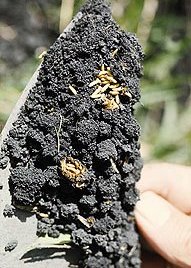
Eggs: Eggs are deposited in the soil in clusters (Fig. 10), held together by a frothy secretion that, when dry, forms a rigid covering. The eggs and frothy secretion are collectively known as an egg pod. The individual eggs look a bit like brown rice.
Egg-laying usually begins in late July and continues into the fall. Most grasshoppers overwinter as eggs in the soil. Egg hatch for potential-pest species usually begins in late May. Hatching begins when the soil temperature has been 15ºC to 16ºC for about 200 hours. Egg hatch is usually spread out over a couple of weeks or more.
Nymphs: Newly-hatched grasshoppers are about 3-5 mm in length. These nymphs are like miniature versions of the adults, but have wing pads instead of wings and, therefore, cannot fly. There are usually five nymphal instars. Grasshopper nymphs mature in 35 to 55 days.
As a general guideline, when many of the grasshoppers are third instars the hatch is over the peak, or almost completed. In the third instar the wingbuds are starting to become more noticeable. Once they reach the fourth instar they have small triangular wingbuds that extends over the first segment of the abdomen. In fifth instars the wingbud is longer and beginning to look like a wing.
Adults: About a week after they become fifth instar nymphs, the grasshoppers will molt into adults, and now have full-sized wings.
Generations: The four potential pest species of grasshoppers mentioned above have one generation per year in the Canadian prairies. Twostriped grasshopper requires a second year to complete their lifecycle at higher elevations, but not in the agricultural regions of Manitoba.
Scouting Techniques
If timely rains keep the vegetation in and around hatching beds green, the grasshoppers may not move to adjacent crops until later in the season. Early scouting should focus on areas of anticipated egg hatch.
Metre-square counts: Many agronomists use "metre-square" counts to assess levels of grasshoppers in their fields. This is simply an estimate of the number of grasshoppers that jump from a square metre area as you walk towards it. To do the counts, view about a square metre of plants about 5 paces ahead of you. As you slowly approach this point, count the number of grasshoppers that leap from the designated area. Exact counts are not always possible, especially when grasshopper numbers are high. Estimating approximate numbers, or a range, as accurately as you can is the best that can be done. Once at the metre-square area, count the remaining grasshoppers, which can be detected by disturbing the plants in the area with your feet to encourage any grasshoppers still present to jump. Do a set of 5 of these counts to determine the mean number of grasshoppers in an area. Do not walk in a straight line when doing a set of these counts. This causes fleeing grasshoppers to "pile-up" in front of you, resulting in overestimations of levels. Instead, continually change the angle of your path through the sample area. Sample other areas in or around the field as needed and note or map areas of higher populations.
Defoliation estimates: If monitoring in crops where defoliation can be used to help make management decisions, randomly select 2 plants at each of 5 areas of the field and estimate defoliation.
Sweep net sampling is useful in determining the stage (instar) and species makeup of grasshopper populations. A standard 15-inch diameter sweep net, with heavy cloth netting, should be used. Information from sweep net samples can be valuable early in the season for determining the stage of grasshopper development. This information can be used to optimize treatment timing.
Similar Insects: When grasshoppers are young they can be confused with some of the larger species of leafhoppers, which can be abundant in the vegetation around fields, but are not crop pests. Leafhoppers are small, active insects that may jump or fly. They are triangular shaped, with the wings held over their body in an arch (Fig. 11). They can be of various colours. When hopping, leafhoppers are hard to distinguish from a jumping early instar grasshopper. Several sweeps with a net will help to determine if the jumping insects are grasshoppers, leafhoppers, or some other insect.

Economic Thresholds
When populations exceed eight to 12 grasshoppers per square metre (sq. yd.), control is usually warranted.
The numbers in the chart below represent guidelines for when it is economical to control grasshoppers. Some of the categories in the table below are vague, stating “not usually”, or “may be” required. This is where some judgment of the situation is required. The value of the crops bordering or near the area being assessed, the growth stage of the crops, and additional stresses on the crop (such as drought) need to be considered.
Control |
Field
Number/m2 |
Roadside
Number/m2 |
Control not usually required |
0-6 |
0-12 |
May be Required |
7-12 |
13-24 |
Control usually Required |
13+ |
25+ |
Control Tips
Biological Controls
Predators: Insects that eat grasshopper eggs include ground beetles, field crickets, and larvae of some species of blister beetles and bee flies. Spiders, robber flies and some wasps feed on grasshopper nymphs and adults. Many species of birds will feed on grasshoppers, including gulls, meadowlarks, hawks, crows, shrikes, killdeers, cranes, etc. Thirteen-lined ground squirrels will feed on grasshopper eggs. Coyotes, skunks and some species of snakes will also eat grasshopper nymphs and adults.
Parasitoids: Parasites of grasshoppers include mites, insects and nematodes. Grasshopper nymphs and adults are sometimes parasitized by sarcophagid and tachinid flies. As well, horsehair worms (which are long, whitish and extremely slender) sometimes parasitize grasshoppers. Grasshopper eggs are sometimes parasitized by the wasp Scelio calopteni.
Pathogens: The protozoan Nosema locustea can reduce grasshopper populations. Aside from killing some grasshoppers, it also reduces food consumption and the number of eggs laid.
The fungus Entomophaga grylli can help control grasshoppers under warm, humid conditions. This fungal disease leaves corpses of its victims clinging to the stems of plants (Fig. 12).

Preserving natural enemies by only using insecticides based on threshold guidelines is an important component of managing grasshoppers. When only low levels of grasshoppers are present, broad-spectrum insecticide applications can do more harm than good by reducing the number of natural enemies, which leaves grasshopper populations free to increase without natural population checks.
Weather: Cool wet weather and heavy rains in the spring can kill young nymphs.
Temperatures which cause substantial mortality to grasshopper eggs (soil temperatures of -15C or less at about 5 cm depth) do not normally occur where grasshopper eggs are laid, because snow cover acts as insulation.
Grasshopper feeding to crops is likely to be greatest in years when dry weather accompanies high populations. Reduced natural vegetation, from drought conditions, can force grasshoppers to move to cultivated crops.
Cultural Controls
Seeding date: Early seeded, vigorous crops develop rapidly before the grasshopper eggs hatch. These crops can then tolerate feeding better than late seeded crops.
Less preferred crops, such as peas or oats, can be used as guard strips around more preferred crops.
Cultural Controls in Winter Cereals: Because there can be a reduced amount of green vegetation present in late summer and fall, newly emerging winter cereals can be very attractive to grasshoppers. Before planting, estimate grasshopper levels around field edges. If grasshopper populations along the borders or within the field are in the range of 11 to 20 per square meter, the following seeding practices may be helpful:
- Seeding date: For winter wheat and other late-summer seeded crops, seeding near the end of the optimum planting window can reduce the risk and severity of grasshopper damage. Recommended seeding dates for winter wheat in Manitoba are September 1 to 15 in northern areas and September 1 to 21 in southern areas.
- Seeding rate: Seed density can be increased along field margins. For example, doubling the planting populations for a strip that is between 20 to 40 metres wide around the field edge. This increased plant stand should slow the movement of grasshoppers into the rest of the field, and compensate for lost seedlings.
If injury from grasshopper feeding is severe along the field edge, it is possible to replant these areas after the first hard frost. Grasshopper will have significantly declined.
Insecticides:
Border Treatments. In many years, treating either the crop margin or the border area surrounding the crop is adequate. Using insecticides with long residual activity would be most effective, particularly if egg hatch may not be completed.
Timing: Insecticide applications are most effective and the costs are lower when they are applied after the eggs hatch and while the nymphs are still concentrated in their breeding areas. It is generally best to control grasshoppers when the majority are in the 3rd to 4th nymph stages. The lowest dosage given on the insecticide label should be used when the grasshoppers are small and the vegetative cover is low.
Pollinator considerations: If a crop or vegetation outside a field contains flowering plants it is best to try to apply insecticides either prior to or after flowering if insecticides are needed. If this is not possible, apply the insecticide as late in the day as possibly, and if possible try to choose an insecticide that is not harmful to pollinators. Most insecticides registered for grasshoppers in Canada are broad-spectrum and harmful to pollinators, the exceptions being chlorantraniliprole (Coragen) and the bran baits Eco Bran and Nolo Bait.
Bran baits: Grasshopper baits, containing an insecticide formulated on bran, are an option to foliar sprays where this is practical. Benefits include low cost, no harm to pollinators and most beneficial insects, and avoidance of insecticide drift. The bait can be spread by application equipment designed to spread granular herbicides or seeds, which is available from most agriculture retailers.
Strip applications: In rangelands about 80 to 95% control of grasshoppers was achieved by alternating treated and untreated swaths. This techniques is referred to as reduced agent and area treatments, and was the most economical method of using insecticides to manage grasshoppers. Untreated swaths harbour biocontrol agents of grasshoppers and weeds.
Photo Credits: Photos 3 and 7 from British Columbia Ministry of Agriculture.
Photo 8 from Shanna Schroeder, New Era Ag.
Photo 9 from Dan Johnson, University of Lethbridge.

